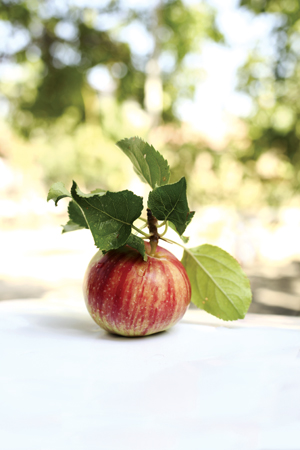Q. We have an apple tree with three different varieties grafted on it. Each year two of the varieties develop a brown patch as if the fruit had been bruised. I also the ground under the tree is littered with small green apples. What is the problem?

A. With apple trees, fruit drop is a natural occurrence. It happens at the end of spring, and it’s called the ‘June Drop.’ The amount will vary from year to year depending on the size of the fruit set. The ‘June Drop’ is Mother Nature’s method of thinning itself. You also manually thin the trees. With the green and cooking types of apples, you thin the clusters down to three or four. With the yellow and red eating apples, one to two is recommended. Stripped apples can be done either way depending on their use. Also, those apple clusters at the end of a branch should be removed completely. This prevents the branches from curving from the weight exposing the apples in the center of the tree. These curved branches will never straighten out. Thinning also redistributes the weight to prevent the limbs from breaking. Limb breakage is a concern in August and September. The brown spots, blemishes, or bruising on the fruit is Sunburn. You’ll find Sunburn damage on those maturing apples on the Southwest side of the tree. The apples at the end of the branches suffer the most damage, as there is little protection from the heat. It’s also another reason for thinning. It’s the foliage that provides shade, Mother Nature’s natural sunblock. Hence, it’s important to feed the trees in the spring to encourage the new growth and protect the crop. The damaged apples from sunburn are still very edible, so I wouldn’t discard them.
Q. Why do the branches on our Redwood tree turn brown and appear as though they have been burned? It seems like this problem occurs every summer. I thought Redwood trees like a sunny location. What can we do to help them out?
A. Redwood trees thrive in a sunny location, but unlike pines, cedars, and cypresses, they’re not drought tolerant. The branches turn brown from insufficient moisture or water stress, especially during hot weather. Young and medium-size trees with a southern, western or combination of both types of exposure along with those trees on drip irrigation suffer the most damage. Your trees were losing moisture faster than they could replace it; hence they burn. Redwoods are surface rooted trees, so some type of mulch is needed to insulate the soil from the afternoon heat. Redwoods wide canopy provides shade along with the debris, natural mulch that falls from the tree. Unfortunately, this debris is routinely removed. Additional mulch is necessary if the lower branches are pruned high off the ground exposing the soil to the hot afternoon sun. Without sufficient shade, the surface roots dry out quickly and water stress as a result. When watering redwoods, the moisture needs to be evenly applied to the area under the canopy. This is where most of the hair or fibrous roots are located, and it’s these roots that transport water and nutrients upward into the tree. The trees suffer when you water only at the base of the tree. The problem with a drip system is that the emitters aren’t spaced sufficiently around the root area. As the tree grows additional emitters need to be added to water the entire area under the canopy. It is very common to find that they haven’t moved from the original installation location. On average, a drip system should run for forty-five minutes depending on the discharge rate. This is considerately longer than a conventional watering system. Three times a week is adequate and more often when the temperatures over ninety degrees. To prevent further damage, need to evaluate how you water plus the frequency and watering pattern along with adding a three-inch layer of mulch. The best of the day to water is in the morning on a rising temperature between 4:00 am and 11:00 am. Unfortunately, the burnt foliage is going to stay brown until the next flush of growth.
Q. How effective is the plant called Gopher Purge in controlling gophers?
A. Gopher Purge is a blue-gray, evergreen perennial that grows four to five feet tall. It is one of the many methods of controlling pocket gophers. It’s most effective when planted in a continuous hedge, four to five feet on center along a property line that divides a garden from open space. If your yard were surrounded by other fenced yards, I would not recommend planting them. In this situation, trapping or poison baits are more effective. For some gardeners, Gopher Purge has been very successful while others have been disappointed.
Leave a Reply